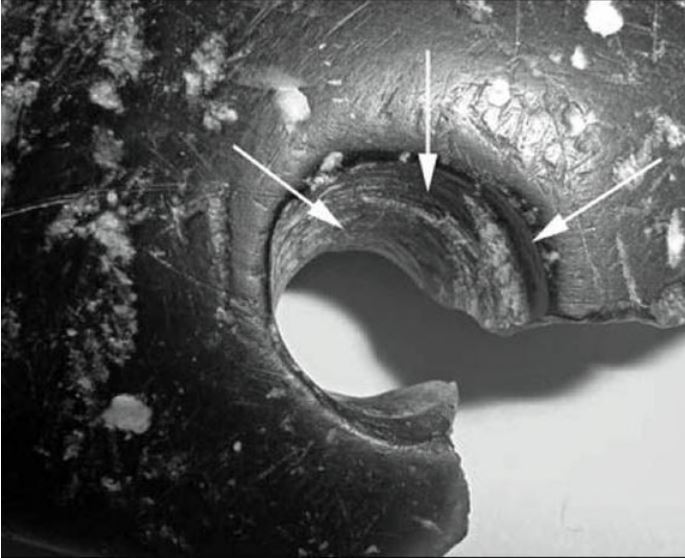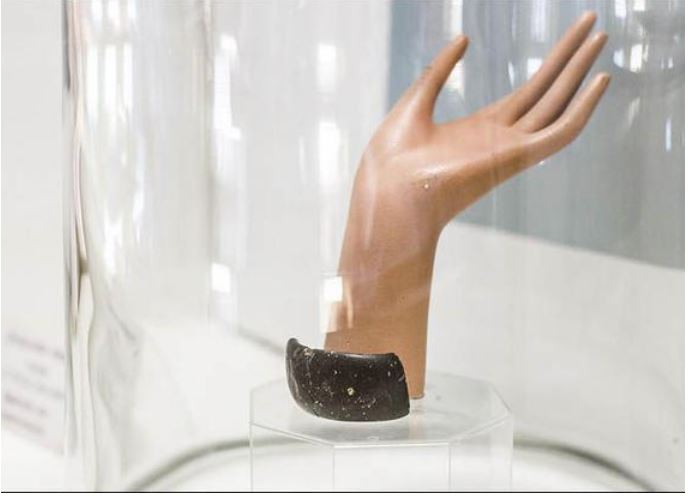Armbåndet blev opdaget på et udgravningsted kaldet Denisova hulen i Sibirien, tæt på Ruslands grænse til Kina og Mongoliet. Det blev fundet ved siden af uddøde dyrs knogler, såsom den uldne mammut, og andre artifakter der daterer sig 125,000 år tilbage.
Hulen er opkaldt efter Denisovan folket - en mystisk art af Hominins fra Homo genus slægten, der er genetisk forskellige fra både Homo sapiens og Neanderthalere.
Vi ved at Denisovan folket udvandrede fra Afrika på et eller andet tidspunkt efter den første bølge a Homo erectus, langt tidligere en os, Homo sapiens.
Denisovan folket var unikt på mange måder, med deres afgrening væk fra andre humanoide forfædre ca. en million år siden. Det nylige fund af en kvindelig Denisovan fingerknogle og nogle tænder, viser at de ikke havde nogle morfologiske ligheder med Neanderthalere eller moderne mennesker.
Dog viser det sig at, de 10,000 vis af år senere, før deres uddøen, sameksisterede med os og Neanderthalere i en periode, og skelet rester og genetiske studier bekræfter at de også parrede sig med vores forfædre, og Neanderthalere.
Kommentar: Følgende del af artiklen er ikke blevet oversat til dansk. Vi undskylder at vi ikke er istand til at oversætte alle artikler på vores netavis, men håber at du har forståelse for at vores lille stab af redaktører og oversættere gør deres bedste for at viderebringe til dig de vigtigste af "tidens tegn", som vi observerer dem. Hvis du har lyst til at se alle detaljer af denne artikel eller at støtte vores bestræbelser med dine egne oversættelser eller forslag, så tøv ikke med at skrive til sott_da@sott.net
Strangely, however, DNA evidence also suggests that, at some point, the Denisovans must have interbred with an as yet unknown and undiscovered species of humans beings.
Skeletal remains show that the Denisovans were probably far more robust and powerful than modern humans, and were, until now, assumed to be a more primitive, archaic type of humans than us.
But, the discovery of the bracelet suggests this was far from true. Amazingly, the skill involved in making this adornment shows a level of technique at least 30,000 years ahead of its time.
Until now, scientists had believed that such skills had only evolved among humans in the Neolithic period, which began at about 10,000 BC. Indeed, originally, they believed that the bracelet had somehow become mixed up with materials dating from a later period.
However, experiments have now definitely ruled that out, and they confirm that it could not have been made by homo sapiens or Neanderthals. After 7 years of analysis, the scientists are confident that the piece was made 30,000 years before the beginning of the Stone Age.

"The skills of its creator were perfect. Initially we thought that it was made by Neanderthals or modern humans, but it turned out that the master was Denisovan."Mikhail Shunkov, deputy director of the the Institute of Archaeology and Ethnography in Novosibirsk, part of the Siberian Branch of the Russian Academy of Sciences, suggested that the find indicates that the Denisovans were more advanced than Homo sapiens and Neanderthals. What is incredible is that the craftsman who made the adornment, seems to have used something similar to a modern drill.
The Siberian Times quotes Dr Derevyanko, who wrote in the Russian magazine, Science First Hand, that when they studied the diameters of the bracelet, they found that the rotational speed of the drill must have been quite high, and with minimal fluctuations.
"The ancient master" he said, "was skilled in techniques previously considered not characteristic for the Palaeolithic era, such as easel speed drilling, boring tool type rasp, grinding and polishing with a leather and skins of varying degrees of tanning."
Held in place by what they believe was a leather strap, the bracelet itself was made from a type of stone called chlorite, which could only have been imported from some 200km (125 miles) away.
The bracelet was very delicate and was probably worn at special occasions by some important person, such as a Denisovan princess. Shunkov explains;
"All jewellery had a magical meaning for ancient people. Bracelets and neck adornments were to protect people from evil spirits, for instance."Commenting on its beauty, Anatoly Derevyanko added;
"But this item, given the complicated technology and "imported" material, obviously belonged to some high ranking person of that society."
"The bracelet is stunning. In bright sunlight it reflects the sun rays, at night by the fire it casts a deep shade of green."The archeologists are reported to have also found a ring made of marble, but they have not yet disclosed any findings about it.







Læserkommentarer
dig vores Nyhedsbrev